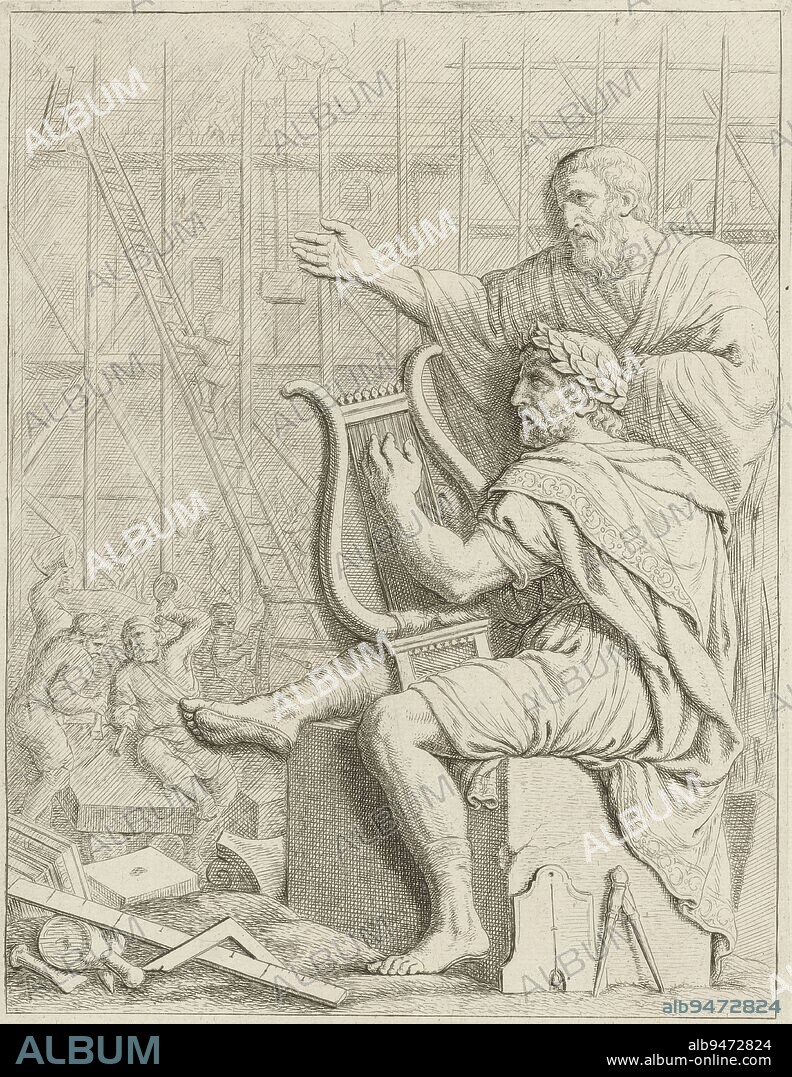alb9472824
Relief with Amphion and Zethos in the Citizens' Hall of the Stadhuis op de Dam, Hubert Quellinus, after Artus Quellinus (I), 1719 - 1783, Relief with Amphion and Zethos above the door of the Justice Room on the east side of the Citizens' Hall in the Stadhuis op de Dam in Amsterdam. On the right Amphion, playing his lyre, with behind him his brother Zethos. According to the myth, thanks to Amphion's lyre-playing, the stones collected by Zethos automatically piled up to form the city wall of Thebes. In the background, however, it is not the wall around Thebes that is being built but Amsterdam's city hall. On the one hand this symbolizes how harmony, here derived from music, promotes the growth of the building. On the other hand, it carries a message for the regents: harmony within the city government and a harmonious policy will lead to harmony among the residents and make the city prosper. Numbered at lower right: XLIV., print maker: Hubert Quellinus, Hubert Quellinus, Artus Quellinus (I), Amsterdam, 1663 and/or 1719 - 1783, paper, etching, engraving, h 292 mm × w 210 mm.

|
Ajouter à une autre Lightbox |
|
Ajouter à une autre Lightbox |



Avez-vous déjà un compte? S'identifier
Vous n'avez pas de compte ? S'inscrire
Acheter cette image.
Sélectionnez l'usage:

Légende:
Voir la traduction automatique
Relief with Amphion and Zethos in the Citizens' Hall of the Stadhuis op de Dam, Hubert Quellinus, after Artus Quellinus (I), 1719 - 1783, Relief with Amphion and Zethos above the door of the Justice Room on the east side of the Citizens' Hall in the Stadhuis op de Dam in Amsterdam. On the right Amphion, playing his lyre, with behind him his brother Zethos. According to the myth, thanks to Amphion's lyre-playing, the stones collected by Zethos automatically piled up to form the city wall of Thebes. In the background, however, it is not the wall around Thebes that is being built but Amsterdam's city hall. On the one hand this symbolizes how harmony, here derived from music, promotes the growth of the building. On the other hand, it carries a message for the regents: harmony within the city government and a harmonious policy will lead to harmony among the residents and make the city prosper. Numbered at lower right: XLIV., print maker: Hubert Quellinus, Hubert Quellinus, Artus Quellinus (I), Amsterdam, 1663 and/or 1719 - 1783, paper, etching, engraving, h 292 mm × w 210 mm
Crédit:
Album / quintlox
Autorisations:
Taille de l'image:
3741 x 4838 px | 51.8 MB
Taille d'impression:
31.7 x 41.0 cm | 12.5 x 16.1 in (300 dpi)
Mots clés:
AMSTERDAM • BARQUE • BAS-RELIEF • BÂTIMENT • BATIMENTS • BUILDING • CHANSONS • CHANT • CORPS MAINS • CROISSANCE • ÉDIFICE • FOND • FORMULAIRE • FORTIFICATION: REMPARTS • FRAVURE • GRAVURE • INSTR. MUS. LYRE A BRAS • LIRA DA BRACCIO • LYRE A BRAS • LYRE • MAIN • MAINS • MUR D'ENCEINTE • MURAILLE • MUSIQUE • MUSIQUE: CHANSONS • MUSISQUE • PAPIER • PORTE (BATIMENT) • PORTE (MAISON) • PORTE • POUSSE • RELIEF • REMERCIEMENT • REMPARTS
 Pinterest
Pinterest Twitter
Twitter Facebook
Facebook Copier le lien
Copier le lien Email
Email
